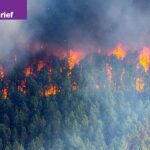Perceived risk, rather than direct damage, was the main driver of the devaluation over the last 20 years, which has cost Oregon timberland $4.5 billion in lost value.
An study conducted by researchers at Oregon State University’s Department of Applied Economics found wildfires and drought have led to $11.2 billion reduction in the value of privately held timberland in California, Oregon and Washington over the past two decades.
The study, published last week in The Journal of Environmental Economics and Management, says increased wildfires and drought stress — which have in turn caused a shift in expectations in the land market —caused a drop of about 10% in the value of private timber in the area between 2004 and 2020.
Wildfire was a significantly bigger driver of devaluation, accounting for 8.7% of the overall value. The majority of that loss in value — nearly 7.42% of the 8.78% — was not due to the direct burning of private timberland, but to the increasing frequency of large wildfires on neighboring land, which has shifted expectations in the land market. (Direct burning did account for 1.36% of those losses.) Drought stresses accounted for 1% of the loss in value.
According to David J. Lewis, a natural resource economist at Oregon State and a coauthor of the study, Oregon timberland lost about $4.5 billion in the time period studied, accounting for about 40% of the decrease in land value researchers measured.
“Our research results indicate that any policy that can successfully reduce the spread of wildfire could reduce risks for timberland owners and provide economic benefits in the form of higher land values,” writes David J. Lewis, a natural resource economist at Oregon State, who coauthored the study, in an email to Oregon Business. “The key question (not answered in our research) is whether the administration’s new wildfire strategy will actually be successful in reducing wildfire risks,” referring to the White House’s plans to develop a national strategy to estimate the impacts of climate change on the value of the nation’s natural capital, including forests, minerals, oceans and rivers.
The increased prevalence of wildfires and droughts due to climate change did not account for all of the value depreciation, but it was a significant driver. The study suggests that recent climate change is responsible for lowering timberland values by $6.2 billion, or 55% of the total devaluation.
The study also noted Oregon was the only state that had private insurance for wildfire suppression expenses, but that policy was dropped in 2023 as a result of rising premiums and deductibles due to increasing wildfire risk. Lewis says the impact of this policy change is outside the scope of the paper’s research.
The OSU study analyzed a dataset of more than 9,000 sales of privately-owned timberland that were a minimum of 10 acres between 2004 to 2020 in California, Oregon and Washington. It then overlayed the transactions with data on small and large wildfires, along with drought data.
In Oregon, west of the Cascades, drought stress losses were 1.6%, and large wildfire losses were 7.7%. East of the Cascades, drought stress decreased timberland value by 1.1% and wildfires caused a 6% devaluation. According to the study, that difference is because in recent years, timberland west of the Cascades was in closer proximity to recent large wildfires.



